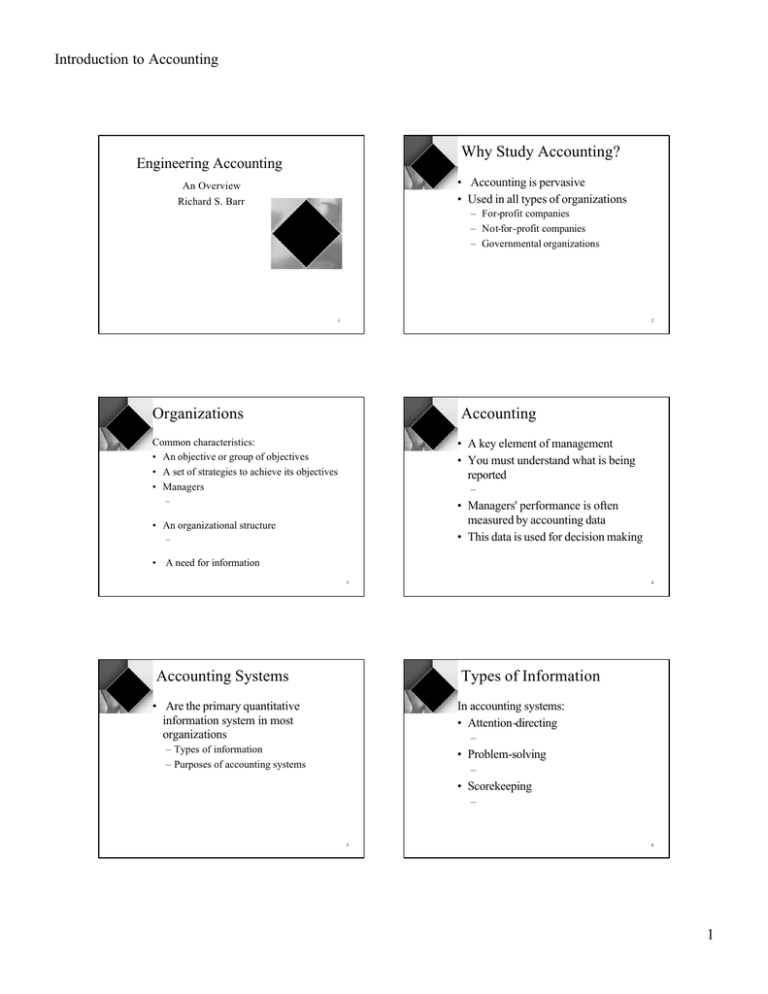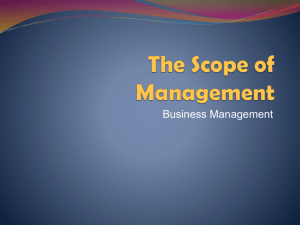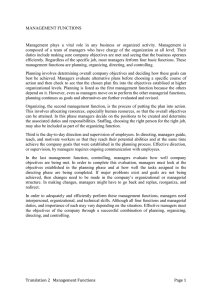Why Study Accounting? Introduction to Accounting Engineering Accounting • Accounting is pervasive
advertisement

Introduction to Accounting Why Study Accounting? Engineering Accounting • Accounting is pervasive • Used in all types of organizations An Overview Richard S. Barr – For-profit companies – Not-for-profit companies – Governmental organizations 1 2 Organizations Accounting Common characteristics: • An objective or group of objectives • A set of strategies to achieve its objectives • Managers • A key element of management • You must understand what is being reported – – • Managers' performance is often measured by accounting data • This data is used for decision making • An organizational structure – • A need for information 3 Accounting Systems 4 Types of Information • Are the primary quantitative information system in most organizations In accounting systems: • Attention-directing – – Types of information – Purposes of accounting systems • Problem-solving – • Scorekeeping – 5 6 1 Introduction to Accounting Purposes of Acctg Systems Accounting Systems • Internal reporting to managers for planning and control • Internal reporting for special decisions, policies, and long-range plans • External reporting Four Standard Types 7 8 Types of Accounting Systems Financial Accounting 1. 2. 3. 4. • Primarily for the external decision maker Financial Tax Management Cost – – – • External reporting follows legal and GAAP requirements • Objective: provide standard view of organization’s past performance Different views for different audiences Our focus: financial and managerial 9 10 Tax Accounting Management Accounting • Based on IRS regulations • Designed primarily for the internal decision maker • Reporting is designed to assist management in – • Some accounting rules differ from financial – Decision making – Planning – Control – • Objective: – 11 12 2 Introduction to Accounting Cost Accounting Financial vs. Managerial • Concerned with the costs of business activities • Managerial accounting: – Focuses on internal uses by management – Products, services, departments, resources – • Supports decision-making • Part of managerial accounting – Emphasizes the future – Is not governed by generally accepted accounting principles – Relevance and flexibility of data – Less emphasis on precision – Draws from other disciplines – Is not mandatory 13 14 THE WORK OF MANAGEMENT Financial vs. Managerial Similarities • Use the same accounting data • Rely on concept of responsibility: – Assigning responsibility to individuals 15 The Work of Management • • • • 16 Planning Planning Organizing and directing Controlling Decision-making • Deciding on objectives and how to attain them • In accounting: – Constructing budgets 17 18 3 Introduction to Accounting Organizing and Directing Controlling • Organizing: deciding how best to carry out established plans and objectives • Directing: overseeing daily activities and keeping organization running smoothly • Implementing plans and using feedback to obtain objectives • In accounting: – – – 19 20 Decision Making Types of Decisions • Choosing between alternatives • Example internal decision makers: • • • • • • • • – – – – – – – Division Manager Plant Manager Foreman Marketing Manager Regional and District Sales Manager Manager of Research and Development Manager of Physical Distribution Make or buy a product Choose raw material to use Select process to use Acquire or discard machinery or equipment Add or delete a product or product line Select products for additional promotion Choice of distribution channels Lease or purchase 21 Performance Evaluation 22 Management by Exception • Financial accounting approach: • Focus on – • Managerial accounting approach • Accounting system should highlight • Used as feedback for controlling • Performance Reports show: – Budgeted - Actual = Variance 23 24 4 Introduction to Accounting Organizational Structure ORGANIZATIONAL STRUCTURE • How are organizations structured? • Three key concepts: – Decentralization – Responsibility accounting – Line and staff relationships 25 26 Decentralization Responsibility Accounting • Delegation of decision-making authority throughout an organization • Managers are given areas of responsibility • Associating revenues, costs, and expenses with individuals 27 28 Line and Staff Relationships Accounting Is Staff • Line positions • The Controller – Directly related to the organization's basic objectives • Staff positions – Chief management accounting executive – In charge of supplying information and advice to line positions – Indirectly related – 29 30 5 Introduction to Accounting Organization Chart Key Points • Three types of accounting information • Financial versus managerial accounting • Four functions of management • Performance evaluation • Organizational structure President/ CEO Sales VP (Staff) Engineering VP Branch Sales Manager (Staff) Manufacturing VP Production Manager Personnel VP (Staff) Financial VP (Staff) Treasurer (Staff) Controller (Staff) 31 32 Big 8 Reasons for Studying Accounting 1. 2. 3. 4. 5. 6. 7. 8. 33 6






